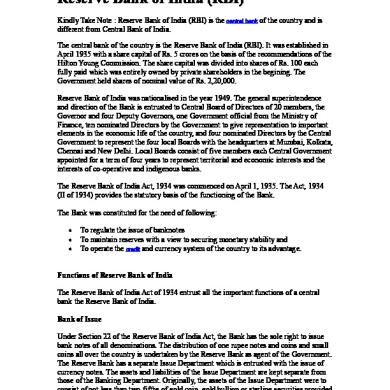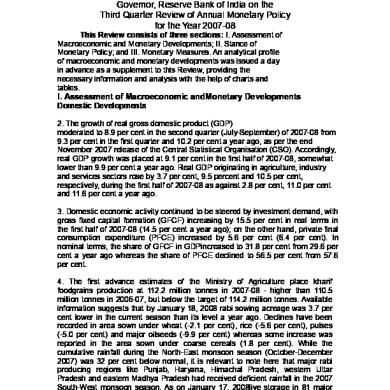Cartoon Presentation On Rbi
This document was uploaded by user and they confirmed that they have the permission to share it. If you are author or own the copyright of this book, please report to us by using this DMCA report form. Report DMCA
Overview
Download & View Cartoon Presentation On Rbi as PDF for free.
More details
- Words: 207
- Pages: 25
Reserve Bank of India (RBI)
Introduction RBI
– The Central Bank of India Need for bank to be constituted ◦ Issue of bank notes ◦ Reserves with a view to security monetary stability ◦ Credit and Currency system at the country to its advantage
Organisational Structure of RBI
ROLES AND FUNCTIONS OF RBI
SUMMARY ROLES
AND FUNCTIONS
1. Price stability 3. Encourage growth
9. Supervising authority
Monetary policy10. Regulator of money and credit
5. Financial stability 7. Development of financial infrastructure 5. Regulate the overall volume of money and credit 6. Lender of last resort 7. Note issuing authority 8. Bankers’ bank
11. Exchange control authority
Credit Control Methods
Need: To
encourage the priority sectors for overall growth.
Facilitate
the flow of adequate volume of bank credit to its industry, agriculture and trade.
To
keep Inflation pressure under check.
To
ensure that Credit is not diverted to undesirable purposes.
To
facilitate the Development of Indian economic growth.
Types of credit control : Quantitative
Method Qualitative Method
Quantitative Methods Bank
rate policy
Open
Market operation
Variation Fixation
of cash reserve ratio
of lending rate
Qualitative Methods Fixation
of Margin Requirement
Regulation Rationing Prior
of consumer credit
of credit
authorisation of schemes
Direct
Action
Introduction RBI
– The Central Bank of India Need for bank to be constituted ◦ Issue of bank notes ◦ Reserves with a view to security monetary stability ◦ Credit and Currency system at the country to its advantage
Organisational Structure of RBI
ROLES AND FUNCTIONS OF RBI
SUMMARY ROLES
AND FUNCTIONS
1. Price stability 3. Encourage growth
9. Supervising authority
Monetary policy10. Regulator of money and credit
5. Financial stability 7. Development of financial infrastructure 5. Regulate the overall volume of money and credit 6. Lender of last resort 7. Note issuing authority 8. Bankers’ bank
11. Exchange control authority
Credit Control Methods
Need: To
encourage the priority sectors for overall growth.
Facilitate
the flow of adequate volume of bank credit to its industry, agriculture and trade.
To
keep Inflation pressure under check.
To
ensure that Credit is not diverted to undesirable purposes.
To
facilitate the Development of Indian economic growth.
Types of credit control : Quantitative
Method Qualitative Method
Quantitative Methods Bank
rate policy
Open
Market operation
Variation Fixation
of cash reserve ratio
of lending rate
Qualitative Methods Fixation
of Margin Requirement
Regulation Rationing Prior
of consumer credit
of credit
authorisation of schemes
Direct
Action
Related Documents

Cartoon Presentation On Rbi
May 2020 0
Cartoon Cartoon
May 2020 24
Rbi
June 2020 22
Rbi
May 2020 16
Cartoon
August 2019 28
Handbook On Statistics India Rbi
December 2019 1More Documents from ""

Banking Allied Services
May 2020 1
Banking Allied Services
May 2020 2
Cartoon Presentation On Rbi
May 2020 0
Add Effectiness Vwrfgh Hehwetr.docx
May 2020 1
Contesting Global Governance
October 2019 30